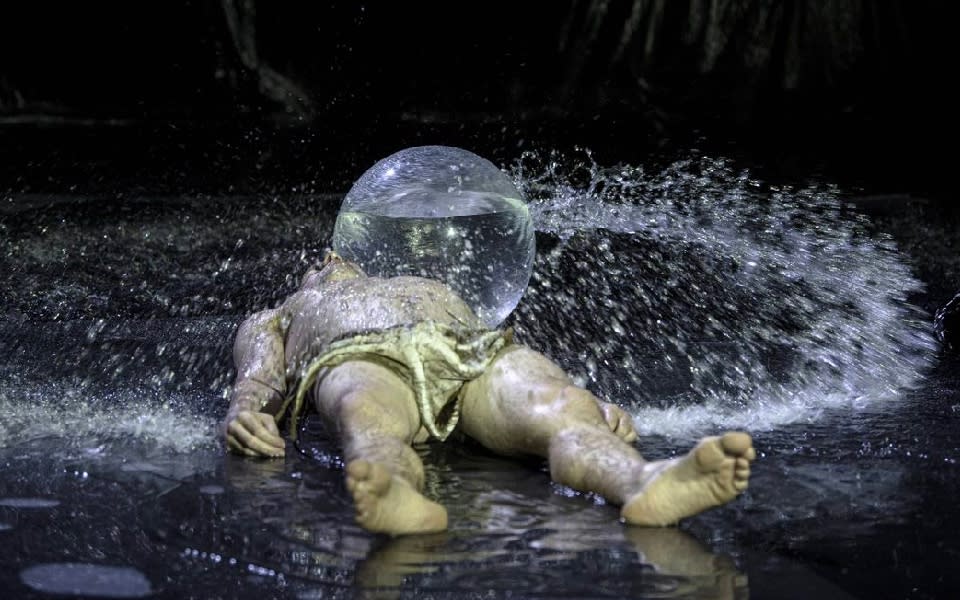Dimitris Papaioannou’s Ink is a stunning contemporary dance

The curtain lifts on the Ink stage drenched in water, surrounded by billowing black curtains, where a fully clothed Dimitris Papaioannou, in wet, figure-hugging black shirt and trousers, interacts with a long, arched, luminous jet of spray, extending for the whole width of the set.
The choreographer then picks up a hollow glass orb, a vessel he uses to collect some of the frothing spray, and spins it on the floor, to redistribute water in a sort of revolving fountain. Finally, he slowly takes a seat to one side, carefully positioning his chair and his head so that, from every corner of the audience, the liquid arch appears to be streaming directly from his mind, while he looks intently at where it lands.
Whether contemplating his own creative process, his own mortality or his artistic legacy, the older artist is interrupted by an inchoate shape crawling underneath the plastic sheeting of the stage floor, making small waves as it moves like a trapped animal. After his attempts to restrain and subdue the shape succeed, Dimistris lifts the plastic sheeting to reveal a young, naked male dancer, Šuka Horn.
The opening scene is followed by a series of movements depicting the evolving dynamic between the older choreographer, himself also a dancer, and the younger intruder and muse, with moments of lust alternating with playfulness, with power reversals and mutual submission, joint inspiration and creative collaboration. A floating island of reeds, a second glass orb with exaggerated glint, an octopus and some tail-wriggling toy fish serve as welcome visual relief from the tension, but also help set the story somewhere along the sea, hinting at the possibility of Summer and sunshine.
Ink offers moments of not-so-thinly-veiled sadomasochism, and yet also moments of impossible tenderness. One that will earn a place in contemporary dance iconography is the sequence where the older dancer, having surrendered to gravity, is seen physically crave a baby, then give birth to one, and finally cradle it gently across the stage. A hazy silhouette of the younger dancer, meanwhile, behind a semi-opaque screen, and positioned so that he appears to be lying above a recumbent Dimitris, is seen engaging in energetic intercourse, telling of the diverging emotional investment each man appears to have in the same relationship.
Ink is unusual in Papaioannou’s body of work in that, as commissioned choreography, he was required to feature in it. To his surprise, he discovered that he enjoyed performing in his own work. But Ink is not representative of his artistic output also for another reason. All of his other major works, Primal Matter (2012), Great Tamer (2017), Seit Sie (2018), created for the Pina Bausch Wuppertal Tanztheatre, and Transverse Orientation (2021), feature dance sequences that are disjointed and dream-like, image following image in a series of tableaux.
As his creative process is not mediated by textual language but only by painting-like compositions of bodies, visual display of light, and speed of dancers’ movement through light are his key defining features, which seldom fit a coherent narrative framework. The two dancers’ bodies in Ink, conversely, have a very important psychological connection with the narrative and move it purposefully forward: Papaioannou created Ink when spending Covid lock-down in Greece, while rehearsing work with Šuka, who was living nearby.
Dimitris takes a huge risk with Ink: that of being self-indulgent. He is best known for epic-scale choreogrphy, such as the opening of the Athens Olympic games in 2004, and for ensemble pieces where light plays as large a part as the dancers themselves. By his own admission, this is a most personal and dark autobiographical composition. This may not be Papaioannou’s best work to date, but certainly was a risk worth taking. With censorship and criminal laws banning homosexuality still within living memory, Ink now stands as an important contribution to a gap in the Western dance canon: an explicitly homoerotic depiction of the tortured dynamic between and older artist and their younger muse and, more specifically, between a choreographer and their principal dancer.
Ink is powerful contemporary dance that is capable of generating strong feelings, ranging from awe to tears of recognition: whichever one will grip you, this work is unlikely to leave you unmoved.
• If you missed the London dates, Ink will next be touring Athens in April and Paris in May 2024

 Yahoo Finance
Yahoo Finance 